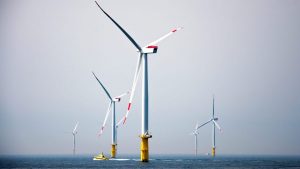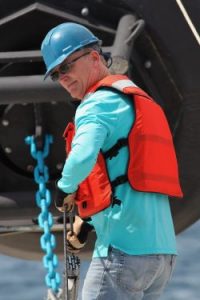After the Biden administration announced plans to develop coastal wind farms, The Well checked in with marine sciences professor Harvey Seim about what that could mean for North Carolina.

An area off the coast of Wilmington is one of seven offshore wind energy areas that are part of the Biden administration’s recently announced plan to lease federal waters to wind power developers. The plan, along with the approval of a wind farm off the coast of Massachusetts and two wind energy areas off the California coast, mark what The New York Times called “the most forceful push ever by the federal government to promote offshore wind development.”
One of those happy to see the renewed interest in wind power is professor Harvey Seim of the earth, marine and environmental sciences department in the College of Arts & Sciences.

Seim was one of the authors of the 2009 feasibility study, Coastal Wind: Energy for North Carolina’s Future. Seim and other Carolina researchers spent nine months looking at wind resources, ecological risks and existing infrastructure, concluding that “large areas off the coast of North Carolina are well-suited for wind energy development and worthy of further investigation.”
That research proved that North Carolina has some of the best wind resources on the East Coast, Seim said, but development of these resources has been slow. Only one of the three offshore wind energy areas — Kitty Hawk, Wilmington West and Wilmington East — identified by the federal government in 2014 has begun development. This summer, Avangrid Renewables’s Kitty Hawk North project became the state’s first offshore project to progress in the permitting process.
The Well checked in with Seim to find out why the other areas haven’t been developed yet and what impact the federal government’s renewed interest in wind power may have on the state.
Why hasn’t there been development in the Wilmington West and Wilmington East areas?
I think it’s highly likely that the Wilmington West lease area will not move forward because of conflict with Northern right whales. Northern right whales are very endangered. I think the population is 400 or less. And the whales come off the coast of northern Florida, Georgia, South Carolina and now southern North Carolina to calve and rear their young in the wintertime.
My impression is the state is pushing hard to get the Wilmington East area leased, and maybe they can add more area that can be developed.
What else is needed to spur the development of wind farms off the coast of North Carolina?

One of the challenges with offshore wind is the tremendous amount of capital that must be invested up front. That’s why it’s critical to provide some form of incentives for someone to take that development risk. So I think it’s really important that the federal government come forward and say, “This is an activity we want to see happen,” and hopefully they put in place those kind of incentives that would allow development to occur nationwide.
That’s the value that the federal involvement potentially provides. It incentivizes the industry nationwide. The United States is still, to my knowledge, far behind Europe and just developing the infrastructure to build and support offshore wind. That infrastructure includes specialized vessels, port facilities, building the parts that go into the wind turbines and things like that. So I think there is a real potential economic benefit to doing this.
It would be exciting to see a coastal community that is responsible for supporting a wind farm, providing the vessels for the maintenance that must be done. I think that it would be wonderful to see that kind of industry footprint along the North Carolina coast.
What are the advantages of wind power compared to other sources of energy?
The great advantage is it’s green. It’s just the wind blowing. The reduction in CO2 emissions is significant. So that’s the great incentive for this. It’s truly green power. And it’s a reliable resource. If you have broad enough distribution of wind farms and they’re tied together, somewhere in that array of turbines you’re going to get wind generation.
What are the disadvantages or challenges?
One of my interests for North Carolina was how do these systems function in hurricanes. There are not many places in the world that currently have wind farms in the path of many hurricanes. So that’s one of the challenges of developing off the coast of North Carolina.
There are also concerns about ecological impacts. One thing that’s obvious from the studies that have been done is that the foundations of the turbines will serve as artificial reefs. In general, it’s probably not a bad idea, but you are also providing rest stops in an otherwise barren area for any species, including invasive species.
People are also concerned about the impact on flying creatures. You just have to understand what the migratory pathways are for the birds and avoid them. If you stay away from those pathways, it really seems like the birds don’t, and the bats don’t, go there.
By
